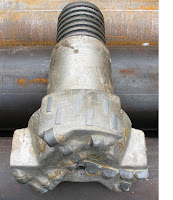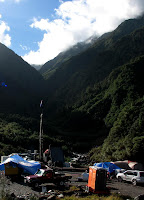We have now completed our first 24 hours of drilling with core recovery and are several days ahead of schedule. We were not expecting to start coring operations until Monday, but we have already reached a depth of 60 m (23/1/2011, 9 a.m) in our first borehole. We are working shifts round the clock and will continue to do so until we reach our final depth. Our current hope is to intersect the fault at 100 m and continue 20 m into deformed granite beneath. However, exactly how deep we drill depends on what we find and technical feasibility. Along with our scientific goals, we recognise that specific aims of this first borehole are to find the fault (exploration) and develop both the technical methods and operational skills to sample it.  Horizon Drilling diamond coring rig at DFDP-1A drill site, Gaunt Creek. Core processing and logging is in tents behind the white container. Alex Pyne (Scientific Drilling Office, Victoria University of Wellington, NZ) is helping and training us with regard to core processing, and Brett Carpenter (Penn. State, USA) brings practical SAFOD experience. They are both helping NZ students learn the art of cleaning and then piecing cores and fragments back together. We drilled at a rate of 1.5 m/hr and obtained 56% core recovery over our first 30 m, but this will hopefully improve as our drillers hone their technique. The rock is shattered and altered to clay by the fault, so it is difficult material to collect.
Horizon Drilling diamond coring rig at DFDP-1A drill site, Gaunt Creek. Core processing and logging is in tents behind the white container. Alex Pyne (Scientific Drilling Office, Victoria University of Wellington, NZ) is helping and training us with regard to core processing, and Brett Carpenter (Penn. State, USA) brings practical SAFOD experience. They are both helping NZ students learn the art of cleaning and then piecing cores and fragments back together. We drilled at a rate of 1.5 m/hr and obtained 56% core recovery over our first 30 m, but this will hopefully improve as our drillers hone their technique. The rock is shattered and altered to clay by the fault, so it is difficult material to collect.
 Brett Carpenter (Penn. State, USA) and Carolyn Boulton (Canterbury, NZ) process a core. They remove it from the metal split that comes out of the core barrel, clean it, record operational data and preliminary notes, and then deliver it to the logging geologists for a detailed description.
Brett Carpenter (Penn. State, USA) and Carolyn Boulton (Canterbury, NZ) process a core. They remove it from the metal split that comes out of the core barrel, clean it, record operational data and preliminary notes, and then deliver it to the logging geologists for a detailed description.
The team of logging geologists has been coordinated by Virginia Toy (Otago, NZ), and is made up of David Prior (Otago, NZ), Dan Faulkner (Liverpool, UK) and Elisabetta Mariani. The cores are described in detail, sampled in key places, and then shrink-wrapped in plastic and boxed for later analysis. The whole team has to work together to communicate what we are learning about the geology back to the drillers, so that they can predict how to better drill the next core and maximise our core recovery. This is a tough job, because nobody has ever drilled into the Alpine Fault before, and it is particularly poorly known what lies beneath the fault.
 Virginia Toy inspects cores from borehole DFDP-1A. Cores are processed (background) and then logged (foreground).
Virginia Toy inspects cores from borehole DFDP-1A. Cores are processed (background) and then logged (foreground).
And in breaking news…
Just as I am about to post this, I am seeing some spectacular cores from near 70 m depth. I think we may have just crossed the principal slip surface of the Alpine Fault and passed into rocks that are very poorly known, but seem to produce great looking cores. I will post a further update after the cores have been cleaned, logged, and the science team have discussed them.
Our video that describes the project is here

 Second photo : Poor core recovery with many fragments of collapsed borehole in the core barrel and a very short run of intact rock. Rates of drilling were less than 1 m per hour and this was one of the best cores collected.
Second photo : Poor core recovery with many fragments of collapsed borehole in the core barrel and a very short run of intact rock. Rates of drilling were less than 1 m per hour and this was one of the best cores collected.














